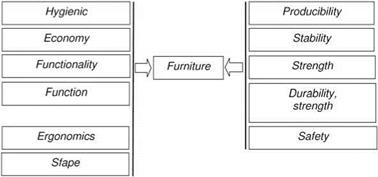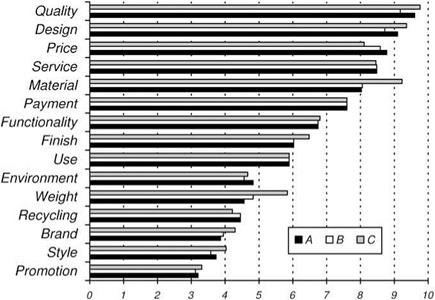Furniture is among the oldest of objects of applied arts, which the human uses. It should be noted here that these constructions differ little from those used today. Chairs, cabinets and even a folding bed found in Tutankhamen’s tomb (Destroches-Noblecourt 1963)
 |
show close similarities to the constructions of contemporary furniture (Fig. 3.2). And some joints, e. g. mortise and tenon joints, have not changed their basic shape for more than 3000 years.
In Poland, many objects of use constituting elements of the equipment of rooms were initially defined as equipment. The term “furniture” is not encountered until inventories from the second half of the eighteenth century. In city registries from the end of the eighteenth century, we find the description: today the term furniture, which names equipment, is widespread, which serves comfort, benefit and decoration (Sienicki 1954).
Throughout the history of the furniture industry, there have been two styles: folk and courtly, as different from one another as different was the economic situation of the citizens. An indicator of the quality of furnishing court interiors, aside from relating to the currently prevailing fashion taste of the customer, was also the degree of his wealth and skill level of the contractor. They were also furniture inherited from their ancestors. Monarchs or other wealthy customers of most furniture maker artists commissioned the interior design of their newly built palaces.
In the folk art, artisans and serfs, esthetics forms of furniture were modeled on furniture from rich homes. Usually the folk carpenters completely transformed the form of furniture by introduction new shapes and functions suitable for the local materials and less perfect techniques (Sienicki 1954). An artisan, being both the designer and producer, knew the customer perfectly, his tastes, dimensions and design expectations and was able to freely adjust the technical object to the needs of the future user. At the same time, he perfected the manufacturing method of furniture in the scope of the technique itself and methods of organising production. The problem of the anonymous user did not appear until the nineteenth century, due to the great economic and social changes, when industry began to dominate over the craft in furniture, which was able to produce furniture for the broad masses of the population. Then the division of furniture on folk and courtly, lost its raison d’etre.
A new systematics of furniture was developed as a result of evolution of their destination. It was begun to distinguish home, office, school, hotel, ship, garden and many other types of furniture. The materials, fittings and additional accessories, especially in kitchen furniture, began to decide of the value of the furniture. Throughout the process of forming a new product, however, the subject for which the product was being made was not noted. At the turn of the nineteenth and twentieth centuries, the strong development of industrial production forced to strictly connect it with the need of ergonomic design. Furniture manufacturers began to realise the postulate of humanising technology. They also began to boldly use such design methods which in the designed product would exhibit a strong relation with the user, thus creating the anthropotechnic system. With this, it was made sure that humanocentric requirements dominated over other technical and technological criteria. As a result of the implementation of many research works, another division of furniture was made, which takes into account the age of the user, as well as anthropometric characteristics. This division differentiates furniture constructions designed for adults, for youth and for children. In standardisation progress, many constructional, dimensional and safety use requirements of furniture were also specified.
In addition to these requirements, the contemporary laws of the market impose increasingly higher and often contradictory expectations towards new products. Therefore, the task of today’s designer-constructor is to identify these requirements, since the degree of satisfying them depends largely on his skills (Fig. 3.3).
Studies of individual market segments of home furniture (Pakarinen and Asikainen 2001; Smardzewski and Matwiej 2004), taking into account their breakdown by design features to solid wood furniture, furniture from boards and upholstered furniture, show that on a ten-point scale, the priority values for potential consumers when deciding whether to purchase a given product are quality and design. The second, in terms of importance, group of factors affecting a consumer’s decision to purchase a given product is, respectively, price, services and material (Fig. 3.4).
|
Fig. 3.3 The requirements for furniture included in the design process |
|
Fig. 3.4 The criteria taken into account by customers when purchasing furniture: A—furniture from solid wood, B—furniture from boards, C—and upholstered furniture (own development based on: Pakarinen and Asikainen 2001; Smardzewski and Matwiej 2004) |
Therefore, designing furniture, aside from the source of creative inspiration, requires support from many complex engineering processes, which consist of the knowledge of the following: markets of producers and consumers, purpose, function and features of furniture, properties of materials used, construction and manufacturing technology, method of securing a furniture piece during distribution, methods of conservation and renovation, as well as recycling used products. Therefore, mutual interaction of all known and unknown design parameters has to be taken into account in the process of designing the cooperation of competent partners.
The innovativeness of designers in creating and constructing avant-garde forms is most visible in skeletal and upholstered furniture. And case furniture presents a more traditional form. For the manufacture of furniture, today practically all available materials are used, including wood, wood-based materials, metal, glass, synthetic materials, rocks, fabrics, leathers, grass, shoots of bushes and others (Table 3.1).
Only the highest quality products having valid hygienic approval and durability certificates should be selected during the design process as constructional materials and those enhancing the surface of the furniture. They should ensure the designer and constructor of the harmlessness of components used, both for the user and for the natural environment.
|
Type of material |
Use in furniture (%) |
|
Wood-based materials |
40 |
|
Wood |
24 |
|
Metal |
16 |
|
Rattan |
7 |
|
Bamboo |
4 |
|
Fabric and leather |
4 |
|
Glass |
2 |
|
Plastic |
2 |
|
Others |
1 |
|
Table 3.1 Raw materials used in designing furniture |
Modern furniture gives rise to four principal issues related to ecology (Dzi^gielewski 1996; Dzi^gielewski and Smardzewski 1995; Dzi^gielewski and Smardzewski 1997):
• the hygiene of the materials used in the construction of the furniture and their impact on man and the environment in which he resides,
• the impact of technologies on the natural environmental of applying modern auxiliary materials for the production of furniture, such as adhesives and painting-varnishing materials,
• disposal of waste occurring in the process of finishing and securing surfaces of furniture elements,
• the possibility to remove or secondary use of materials of worn furniture.
• Taking this into account, the following requirements concerning ecological furniture can be determined:
• designing furniture with a long life span in terms of its design and functionality,
• the use of ecological constructional and finishing materials,
• eco-friendly method of packing furniture,
• good possibility of using, processing or removing the materials of worn furniture.
In today’s furniture constructions, the primary constructional materials, aside from wood, are wood-based materials such as chipboards, fibreboards, MDFs and plywood. Chipboards and MDFs constitute a minimum source of emission of carcinogenic free formaldehyde into the air. It is assumed that the emission of formaldehyde should not exceed 0.1 ppm (L^cka et al. 1995). For the first time, the production of formaldehyde-free boards was undertaken in Germany and Ireland, through the use of adhesives based on isocyanate resins. However, the content of formaldehyde does not provide full information about formaldehyde emitted into the atmosphere from furniture.
Therefore, the assumption alone that we use ecological constructional materials in the design of furniture does not solve the issue of the “greenness” of the furniture. In designing and constructing ecological furniture, another important factor is also the application of organic adhesives and finishing materials (Proszyk and Bernaczyk 1994; Radlinski 1996; Scheithauer and Aehlig 1996).




